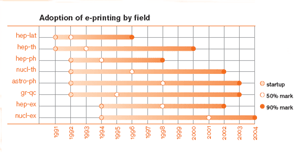The growth of e-printing
Before the days of the World Wide Web, scientists would mail their colleagues preprints, hard copies of papers submitted to scientific journals. In 1991, particle physicists began posting these papers on the Web, calling them e-prints. Today, the e-print archive at arXiv.org includes archives of all fields of physics.
In the accompanying chart, comparing the number of e-print submissions since 1991 with the submissions made in 2004 gives an indication of the pace at which e-printing was adopted by fields related to particle and high-energy physics.
Scientists in lattice gauge theory (hep-lat), among the first to use an e-print archive, had already posted half their preprints (by 2004 standards) in 1992. Lattice gauge theory is a relatively small community of highly computer-literate researchers with a strong tradition of collaboration. By 1996, the lattice community had posted 90% of its annual number of preprints on the e-print archive, using the 2004 submission numbers as comparison.
 Source: SPIRES |
The earlier a field has reached the 90% point, the more likely the field has reached full adoption. Fields that have reached the 90% mark rather late have been either slow at adopting e-printing or have experienced strong growth in the number of e-prints produced in recent years. These latter fields include astrophysics (astro-ph), general relativity and quantum cosmology (gr-qc), and nuclear experiments (nucl-ex).
The widely-practiced field of general relativity and quantum cosmology, with scientists distributed around the world, has the longest time span (8 years) between reaching the 50% and the 90% marks. Adoption of e-printing may have been slow in some of the contributing countries. In fact, only 21% of gr-qc papers in 2004 had an author based in the United States, the smallest percentage of any archive.
Heath O'Connell, Fermilab
Click here to download the pdf version of this article.






